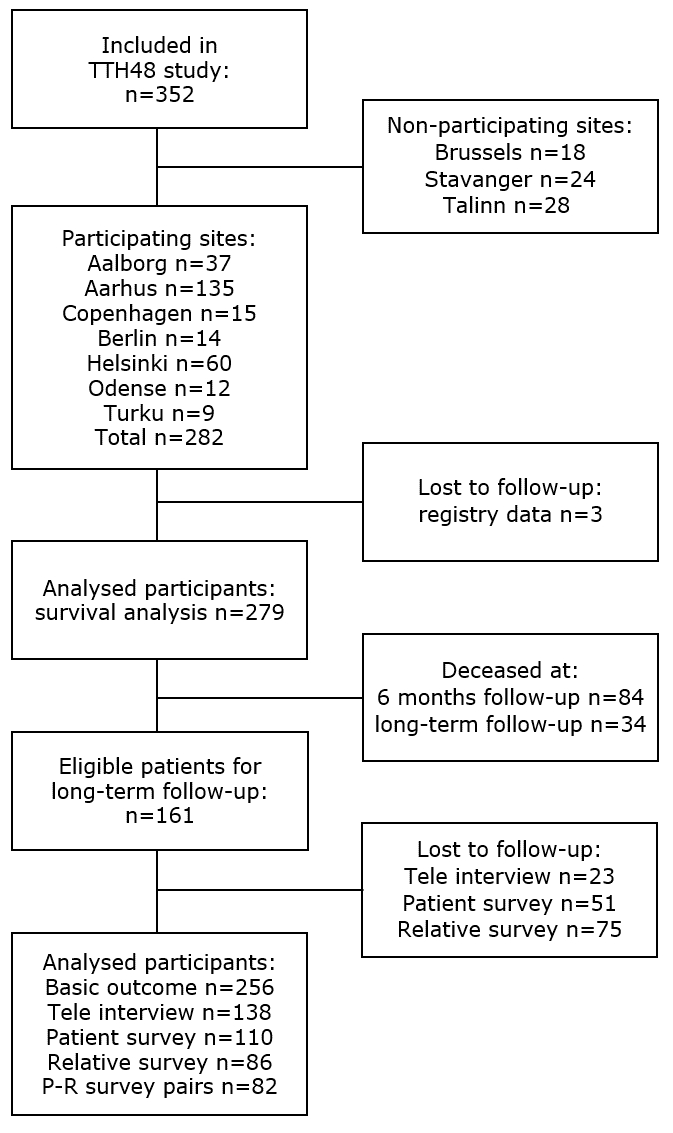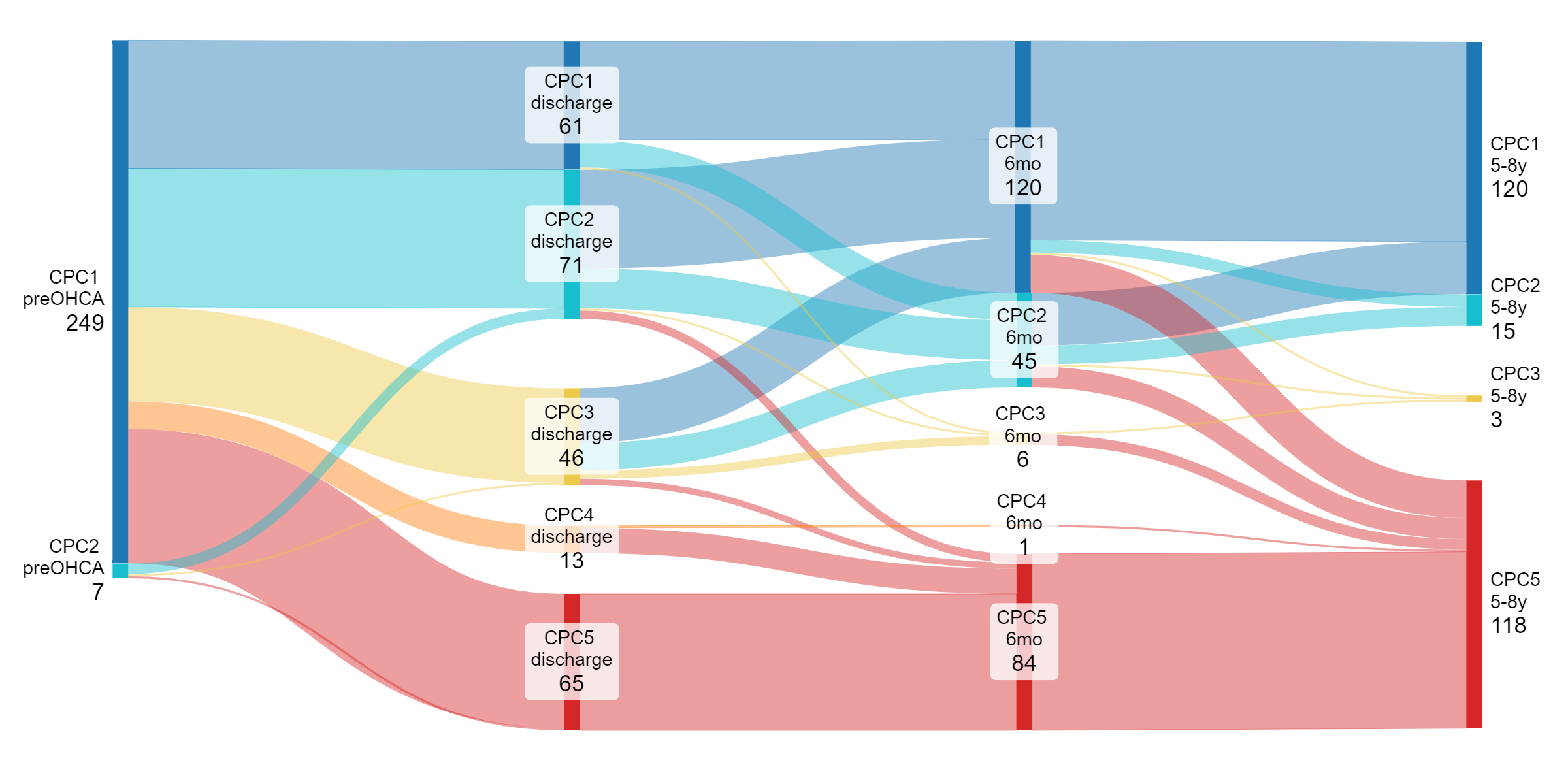Final ID: LBOr03
Long-term functional outcome and quality of life 5-8 years after the TTH48 trial
Abstract Body: Introduction
The prevalence of out-of-hospital cardiac arrest (OHCA) survivors with potential long-term functional sequelae is potentially growing due to improved survival rates and the rising elderly population. However, information on functional outcome and quality of life several years after OHCA is limited.
Research Questions and aims
The aim was to determine the functional outcomes and quality of life several years post OHCA.
Methods
This is a long-term, follow-up, sub-study of the TTH48 multicenter trial (ClinicalTrials.gov: NCT01689077) which randomized OHCA survivors to 24 or 48 hours of targeted temperature management (TTM) at 33°C. Survival rates were collected from medical registries at participating sites. Survivors were contacted 5-8 years post OHCA for a pooled treatment group analysis. Functional outcome (CPC) and quality of life (EQ-5D-5L) were acquired from telephone interviews. Anxiety (HADS-A), depression (HADS-D), PTSD (ITQ), sleep (MISS), fatigue (MFI-20), cognitive decline (IQCODE) and participation (USER-P) were measured by self- and relatives-reported questionnaires.
Results
In total, 279 patients were included at the participating sites, 161 (58%) were still alive, 138 (86%) participated in the telephone survey, 110 (68%) patients and 86 (53%) relatives in the questionnaire survey (see Figure 1). A majority of the survivors (98%) had favorable outcomes (CPC 1-2, see Figure 2). Quality of life was comparable to the background population. On average participants were 66 years of age and had lived 5.9 quality-adjusted life-years (QALYs) after an average of 6.8 years post OHCA. Among OHCA survivors, 6% met the criteria for anxiety, 3% for depression and 5% for PTSD. Sleep problems were reported by 25% and fatigue problems by 45%. In total, 41% had paid work: 16% at full-time (≥36 hours a week) and 25% at part-time (<36 hours a week). Among relatives, 7% met the criteria for anxiety, 1% for depression, 4% for PTSD, and 52% reported that the patients had cognitive decline post OHCA.
Conclusions
A vast majority of survivors had favorable outcomes 5-8 years post OHCA. Quality of life was comparable to the background population and quality-adjusted life-years were acceptable. Labor market attachment was reasonable despite the age of participants. The long-term prevalence of affective disorders among patients and relatives was modest. However, self-reported sleep and fatigue problems and relatives-reported cognitive decline were more prevalent.
The prevalence of out-of-hospital cardiac arrest (OHCA) survivors with potential long-term functional sequelae is potentially growing due to improved survival rates and the rising elderly population. However, information on functional outcome and quality of life several years after OHCA is limited.
Research Questions and aims
The aim was to determine the functional outcomes and quality of life several years post OHCA.
Methods
This is a long-term, follow-up, sub-study of the TTH48 multicenter trial (ClinicalTrials.gov: NCT01689077) which randomized OHCA survivors to 24 or 48 hours of targeted temperature management (TTM) at 33°C. Survival rates were collected from medical registries at participating sites. Survivors were contacted 5-8 years post OHCA for a pooled treatment group analysis. Functional outcome (CPC) and quality of life (EQ-5D-5L) were acquired from telephone interviews. Anxiety (HADS-A), depression (HADS-D), PTSD (ITQ), sleep (MISS), fatigue (MFI-20), cognitive decline (IQCODE) and participation (USER-P) were measured by self- and relatives-reported questionnaires.
Results
In total, 279 patients were included at the participating sites, 161 (58%) were still alive, 138 (86%) participated in the telephone survey, 110 (68%) patients and 86 (53%) relatives in the questionnaire survey (see Figure 1). A majority of the survivors (98%) had favorable outcomes (CPC 1-2, see Figure 2). Quality of life was comparable to the background population. On average participants were 66 years of age and had lived 5.9 quality-adjusted life-years (QALYs) after an average of 6.8 years post OHCA. Among OHCA survivors, 6% met the criteria for anxiety, 3% for depression and 5% for PTSD. Sleep problems were reported by 25% and fatigue problems by 45%. In total, 41% had paid work: 16% at full-time (≥36 hours a week) and 25% at part-time (<36 hours a week). Among relatives, 7% met the criteria for anxiety, 1% for depression, 4% for PTSD, and 52% reported that the patients had cognitive decline post OHCA.
Conclusions
A vast majority of survivors had favorable outcomes 5-8 years post OHCA. Quality of life was comparable to the background population and quality-adjusted life-years were acceptable. Labor market attachment was reasonable despite the age of participants. The long-term prevalence of affective disorders among patients and relatives was modest. However, self-reported sleep and fatigue problems and relatives-reported cognitive decline were more prevalent.
More abstracts on this topic:
A Trial of Patients Receiving Remote Ischemic Conditioning in Early Stroke (PRICES) in a Tertiary Hospital in the Philippines: An Open Label Study
Ang Kevin Royce, Juangco Dan, Hernandez Maria Kim
Anxiety disorder, depression and coronary artery disease: associations and modification by genetic susceptibilityNakada Shinya


